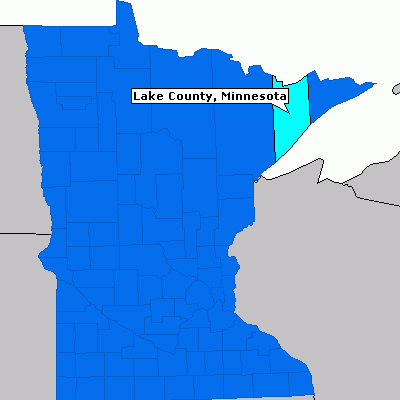Founded March 1, 1856 Area 7,747 km² | Website www.co.lake.mn.us Population 10,777 (2013) Unemployment rate 5.1% (Apr 2015) | |
 | ||
Destinations Boundary Waters Canoe Ar, Grand Marais, Ely, Two Harbors, Lutsen - Minnesota Points of interest Palisade Head, Two Harbors Light, Gooseberry Falls State Park, Lutsen Mountains, Split Rock Lighthouse | ||
Lake County is a county located in the U.S. state of Minnesota. As of the 2010 census, the population was 10,866. Its county seat is Two Harbors.
Contents
- Map of Lake County MN USA
- History
- Geography
- Major highways
- Adjacent counties
- National protected area
- Demographics
- Politics
- Cities
- Townships
- Census designated place
- Unorganized territories
- References
Map of Lake County, MN, USA
History
Lake County was founded on February 20, 1855, as Superior County, though its name was changed on March 3, of that year to Saint Louis County. On March 1, 1856, Saint Louis County became Lake County, while Newton County to the west was renamed Saint Louis County.
Prior to the arrival of Europeans, the area had long been inhabited by Native American groups. At the time of European contact, the principal Native American groups in the region were the Dakota (Sioux) and Ojibwe (also called Anishinabe or Chippewa). The economy of these groups was based on hunting, fishing and gathering, with wild rice being of particular importance. The first Europeans to explore the area were the French in the late 17th century who were followed by trappers, fur traders, missionaries, and explorers. Beaver Bay was the first city in Lake County in 1855.
In 1868, iron ore was discovered on the Vermilion Range by George Stuntz. In 1884, the first shipment of ore left Agate Bay, marking Minnesota's entry into the iron ore industry. During the late 1880s, commercial fishing began on Lake Superior with the coming of Swedish and Norwegian immigrants to the North Shore. In 1890, the Merritt brothers discovered the Mesabi Range. The Two Harbors Lighthouse was built on Agate Bay in 1892. Ten years later, five Two Harbors businessmen signed the articles of incorporation for a new mining company named 3M. Today, 3M Corporation has over 70,000 employees worldwide and produces more than 50,000 adhesive household products, now has its headquarters in Saint Paul.
In 1906, the Court House, which stands to this day, was built. In 1907, one of the nation's first steel ore docks was built in Two Harbors. In 1944, one of the first HMOs in the United States was created in Lake County to serve railroad employees. A second iron ore boom took place in the 1950s with the development of the taconite beneficiation process for turning lean, low-grade iron ore into a shippable product.
Geography
According to the U.S. Census Bureau, the county has a total area of 2,991 square miles (7,750 km2), of which 2,109 square miles (5,460 km2) is land and 881 square miles (2,280 km2) (29%) is water. It is the fifth-largest county in Minnesota by area.
Lake County is located in the Arrowhead Region of Northeastern Minnesota covering 2,062 miles. The county is known for its natural beauty; within its boundaries are four state parks and a National Forest. Lake County offers superior hiking, camping, fishing and winter recreational opportunities. Lake County has Lake Superior, the largest freshwater lake in the world right at its side. With its rugged beauty and pristine shoreline, Lake County offers many recreational opportunities as well as historical shipwrecks, two operating lighthouses and two public marinas. Lake County is home to mining, logging, wood products, lumbering, shipping and transportation, manufacturers, great health care and tourism for all ages.
Major highways
Adjacent counties
National protected area
Demographics
As of the census of 2000, there were 11,058 people, 4,646 households, and 3,140 families residing in the county. The population density was 5 people per square mile (2/km²). There were 6,840 housing units at an average density of 3 per square mile (1/km²). The racial makeup of the county was 97.99% White, 0.10% Black or African American, 0.70% Native American, 0.18% Asian, 0.01% Pacific Islander, 0.14% from other races, and 0.88% from two or more races. 0.57% of the population were Hispanic or Latino of any race. 22.3% were of Norwegian, 17.8% German, 14.3% Swedish, 8.4% Finnish, 6.3% Irish and 5.4% English ancestry.
There were 4,646 households out of which 27.10% had children under the age of 18 living with them, 57.80% were married couples living together, 6.60% had a female householder with no husband present, and 32.40% were non-families. 28.00% of all households were made up of individuals and 12.70% had someone living alone who was 65 years of age or older. The average household size was 2.32 and the average family size was 2.83.
In the county, the population was spread out with 22.30% under the age of 18, 6.60% from 18 to 24, 24.50% from 25 to 44, 26.70% from 45 to 64, and 20.00% who were 65 years of age or older. The median age was 43 years. For every 100 females there were 99.70 males. For every 100 females age 18 and over, there were 99.60 males.
The median income for a household in the county was $40,402, and the median income for a family was $46,980. Males had a median income of $39,719 versus $26,500 for females. The per capita income for the county was $19,761. About 5.50% of families and 7.40% of the population were below the poverty line, including 9.40% of those under age 18 and 5.70% of those age 65 or over.
Politics
Lake County has a historic Democratic/Labor lean. It was the top county for Socialist Party of America candidate Eugene V. Debs in 1908, 1912, and 1920. The last Republican to carry the county was Herbert Hoover’s failed run for re-election in 1932, although in the 1932 election Socialist Norman Thomas received 19.32% of the county’s vote, one of the highest percentages in the country.
